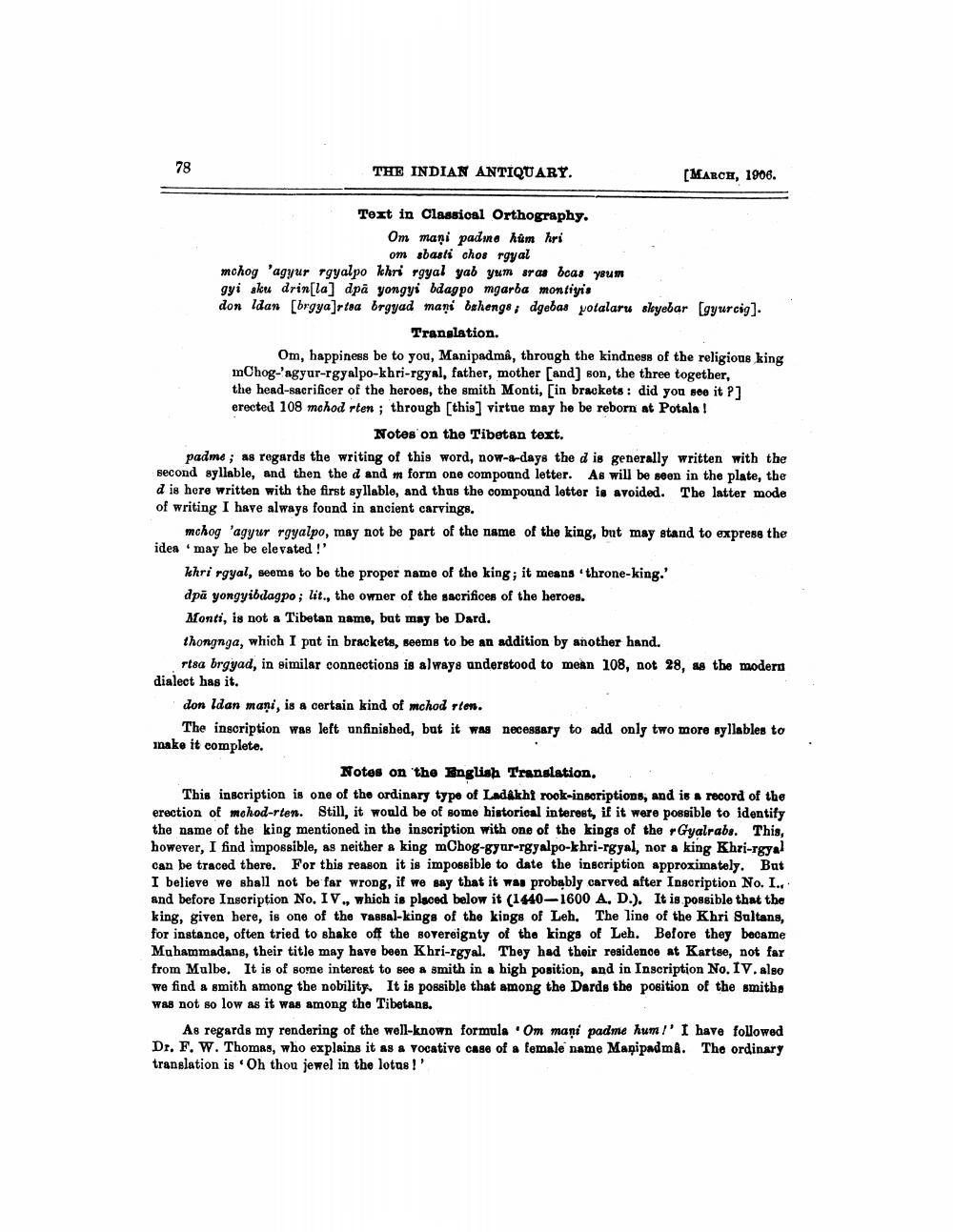________________
THE INDIAN ANTIQUARY.
[MARCH, 1906.
Text in Classical Orthography.
Om maņi padme hüm hri
om sbasti chos rgyal mchog 'agyur rgyalpo khri rgyal yab yum sras boas yeum gyi aku drin[la] dpa yongyi bdagpo mgarba montiyis don Idan [brgya]rtsa brgyad mani beheng8; dgebas yotalaru skyebar (gyurcig].
Translation. Om, happiness be to you, Manipadma, through the kindness of the religious king mChog-'agyur-rgyalpo-khri-rgyal, father, mother (and) son, the three together, the head-sacrificer of the heroes, the smith Monti, [in brackets : did you see it ?] erected 108 mohod rten; through [this] virtue may he be reborn at Potala!
Notes on the Tibetan text. padme; as regards the writing of this word, now-a-days the d is generally written with the second syllable, and then the d and m form one compound letter. As will be seen in the plate, the d is here written with the first syllable, and thus the compound letter is avoided. The latter mode of writing I have always found in ancient carvings.
mchog 'agyur rgyalpo, may not be part of the name of the king, but may stand to express the idea 'may he be elevated !'
Ichri rgyal, seems to be the proper name of the king; it means throne-king.' dpā yongyibdagpo; lit., the owner of the sacrifices of the heroes. Monti, is not a Tibetan name, but may be Dard. thongnga, which I put in brackets, seems to be an addition by another hand.
rtsa brgyad, in similar connections is always understood to mean 108, not 28, as the modern dialect has it.
don ldan mani, is a certain kind of mchod rten.
The inscription was left unfinished, but it was necessary to add only two more syllables to inake it complete.
Notes on the English Translation, This inscription is one of the ordinary type of LadAkht rook-insoriptions, and is a record of the erection of mohod-rten. Still, it would be of some historical interest, if it were possible to identify the name of the king mentioned in the inscription with one of the kings of the Gyalrabs. This, however, I find impossible, as neither a king mChog-gyur-rgyalpo-khri-rgyal, nor a king Khri-rgyal can be traced there. For this reason it is impossible to date the inscription approximately. Bat I believe we shall not be far wrong, if we say that it was probably carved after Inscription No. I., and before Inscription No. IV., which is placed below it (1440-1600 A, D.). It is possible that the king, given here, is one of the vassal-kings of the kings of Leh. The line of the Khri Sultans, for instance, often tried to shake off the sovereignty of the kings of Leh. Before they became Muhammadane, their title may have been Khri-rgyal. They had their residence at Kartse, not far from Mulbe. It is of some interest to see a smith in a high position, and in Inscription No.IV. also we find a smith among the nobility. It is possible that among the Dards the position of the smiths was not so low as it was among the Tibetang.
As regards my rendering of the well-known formula Om maņi padme hum!' I have followed Dr. F. W. Thomas, who explains it as a vocative case of a female name Manipadma. The ordinary translation is Oh thou jewel in the lotus!'




